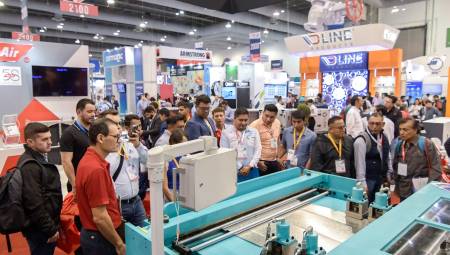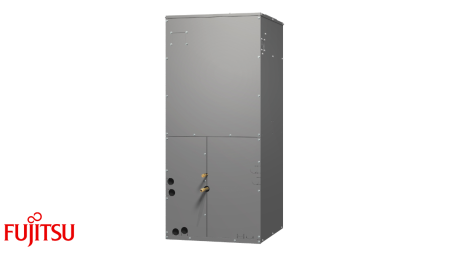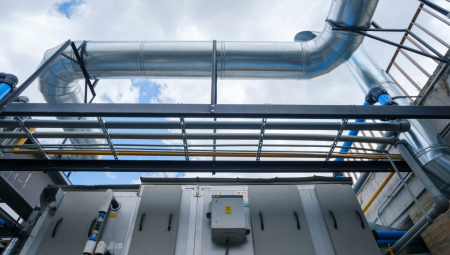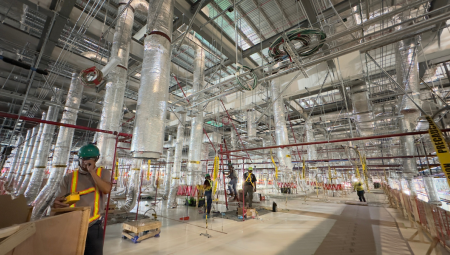Protecting the mechanical equipment of a building is almost as important as protecting the structure. This was evident with the earthquake, in which 75% of the costs for repair, according to experts, are due to damage related to mechanical equipment. To avoid this, the key is in the application of the seismic resistant design.
The mechanical equipment of a building consists of permanent and backup energy systems, air conditioning, air extractors and sanitary systems, among others. These give operability to the structure, turning it into a habitable place that allows the realization of its different functions.

The secondary elements are addressed in the standard of "Seismic Design of Buildings", NCh433 of.96, in general, "criteria that are insufficient, as was proven in different buildings and production plants that were not operational after earthquake", says Christopher Rooke, general manager of Silentium, a company specialized in vibration control and seismic restriction of equipment. What criteria? For example, the standard establishes design requirements of non-structural elements, their anchorage and interaction with the resistant structure, among other aspects, but does not consider the case of equipment that incorporates vibration insulators, nor the need to include seismic restrictors. The behavior of a non-structural element rigidly anchored to the structure is very different from that of another that incorporates elements for vibration control. For which it is under study to withdraw chapter 8 of the NCh433 and create an independent standard for the "Seismic design of non-structural elements and their anchors" (see box Regulations under study).

Of course. The operability of the structure must be ensured. To achieve this, there are two aspects to consider in the event of a catastrophe: facilitating the safe evacuation of occupants and having the necessary protection measures to prevent the movement of equipment.
Variables
Just as safe structures are designed and built, there are also three variables that should be considered to control the effects of an earthquake on all types of installed mechanical equipment. These are:

1. Vibration control:
Pipes carrying fluids, equipment in operation, even air depending on speeds, generate noise and vibrations. The noise travels through the airway, while the vibrations move through the structures, traveling long distances, generating problems both in people and in the structure itself. From here the vibration control elements are born, which are selected based on the frequency of the equipment and the characteristics of the place where it is located. The elements for vibration control can be neoprene, spring, compressed air or even active control, and the choice of this element varies depending on the level of vibration transmission reduction required – sensitive or critical areas require greater vibration isolation – the weight of the equipment and the place where it will be installed (at ground level, on a slab, or on an additional structure)," says Rooke. Follow.
2. Seismic Restriction:
Vibration control adds additional risk. These elements generate a special vulnerability in the equipment in the presence of an earthquake, since they can eventually "enter into resonance" with the seismic wave, strongly enhancing the vertical and horizontal displacement of the equipment. The general solution to protect mechanical equipment is to incorporate "seismic restriction", a tailor-made design of the components, ranging from types of bolts to limiting stops or axial bracing elements, which prevent them from moving and remaining operational, and whose function is to limit movement in the event of an earthquake.
3. Assembly:
The third variable is linked to the assembly of the equipment, in direct relation to the type of anchors to the surfaces. In this sense, NCh 433.Of.96 Chapter 8.5, indicates complementary aspects that the secondary elements must consider.

"To prevent anchor bolts from being subjected to shear stresses caused by seismic stresses, additional fasteners must be arranged. In cases where this is not practical, anchor bolts should be designed to withstand 100% increased seismic shear stress. In no case will equipment without anchoring be accepted." Just as the vibration control and seismic restriction elements are designed according to the type of equipment, its weight and the place where it will be located, so are the anchors that join the equipment with the vibration control element, and this to the structure of the building. "They have to withstand the same g-force (force of gravity) or force of movement of the earthquake to stay in position," says Norbert-Julius Hasenkopf, commercial manager of Müpro Chile, a company that manufactures fastening systems. We show three specific cases of mechanical equipment and its behavior after the earthquake: Sanitary Networks, Equipment and Air Conditioning Systems.
Health networks
In the health infrastructure there are "public-type networks, those that go underground and those of a home type arranged on the surface. Although they are systems that conduct water, whether drinkable, served, or any other flow, they differ both normatively and technically, "says Carlos Acevedo, sanitary engineer and advisor to ProCobre.
According to the experts consulted, the networks arranged on the surface behaved well after the earthquake, except for "those that presented damage inherited from the earthquake of 85', and that were built under standards that are already obsolete," says Rodrigo Muñoz, operations manager of the sanitary business unit of Constructora El Sauce S.A. On the other hand, the buried public health networks "had certain problems, in particular those pipes that were confined within a land that suffered displacement, generating crushes and movements," he continues. We stop at the latter. In buried pipes, an associated issue is soil.
First. "When a buried net design is made, we are not only talking about several km in length, but also a journey through different types of soils. In many cases it happens that the soil canny that is originally studied is made according to four or five points, but in the route there are changes of soil, and it is likely that the estimate is not the faithful reflection for an adequate design, so it can be defective and the pipes are poorly sized, " Muñoz continues.

Second. "With the movement of the ground, the pipes are usually dismantled between their joints, producing problems of embanque, that is, a kind of plug through which water begins to come out through the chambers. As a rule, it is required that the buried pipe be contained in a bed of sand or earth and the ground compacted by layers, "says Acevedo.
Third. The ability to carry is lost. This means that the movement causes the design slope to be lost, a special condition for sewer networks. For example, "a sewer pipe that works by gravity needs a straight line between inspection chambers and a slope for water to drain. Then, in the face of seismic movements, the ground is usually differentiated, which causes slope losses, deformations, breaks and crushing of the pipes, "says Muñoz.
In the case of interior pipes in buildings, "they must withstand the differences in movement, especially if they are anchored from floor to sky, since they move differently in an earthquake, so the pipes begin to oscillate and end up falling," says Rooke. In such a case, "together with the vibration control element, it is important that the solution contemplates some type of seismic restriction, that is, an element that in the event of an earthquake restricts movement, preventing the pipe from oscillating to the extreme of being destroyed," says Rooke.

How to avoid it? "For those pipes that are hung on the slab for example, it is possible to implement connections with some degree of movement, for example rings that facilitate the pipe to move pendulum-like, and that enable horizontal movement so that they do not break," says Hasenkopf. Likewise, "the pipes must be made more flexible with flexible joints, so that they absorb these differences in movement, generating elastic connections between equipment and structures and implementing longitudinal and transverse straps to the route of the pipe, to restrict its movement in the face of an earthquake," Rooke continues.
Air conditioning equipment and systems
Drinking water in household networks passes through equipment. In this type of equipment are ponds, accumulators or boilers and boilers, among other types of elements.
After the earthquake, "one of the most recurrent faults were observed in the joints of the accumulators that gave way, which is why some buildings were flooded," says Kiko Zettler, head of marketing at Anwo. Another shortcoming to consider. Generally, to optimize space, they are located on the roofs or on mechanical floors of buildings, which increases the pressure to which they are subjected in the event of an earthquake. An example. "The accumulators have inputs on the sides and on the exit. When an accumulator is installed on the upper floors, we recommend that at its upper end it has a vacuum breaker, which is a valve that in the event of an eventual cut of pipes, this piece does not let out water but air, preventing the equipment from deforming, as happened in those cases that did not have this element, " says Zettler.
However, all these equipment are of large dimensions and weights, so they need a solid platform to be anchored, in addition to complying with vibration control and seismic restriction. The equipment in operation generates vibrations, so they must incorporate vibration isolating elements, which when not protected in seismic terms, produced the displacement of the equipment from its base.
Within the air conditioning systems meanwhile, among the main ones are chillers, air handling units or UMA s, cooling towers and fans. In the same way as the other equipment, the air conditioning systems "can be damaged both by the absence of seismic restriction elements and by the application of fragile fixings or anchors, causing collapse, as happened in the recent earthquake. Another cause of damage to air conditioning equipment is the vibration produced by seismic waves, especially by the voltage axial effect, with which, if the air conditioning equipment is not well supported, they will suffer damage, "says Hasenkopf.
Supervision and certification
Just as there is a calculation project for the structure, it is also a priority to have one of the secondary elements, whether these are sanitary networks, equipment, air conditioning systems or others. In practice, while the Construction Manager is in charge of supervising the quality of the construction, the Technical Inspection of Work (ITO) is the entity responsible for verifying that in each of the stages of construction the design is fulfilled.



Likewise. It is essential that the seismic resistant elements that are incorporated to protect the non-structural elements in a project, have the certification of an external body that verifies their potential to resist the forces of the earthquake. Without going any further, with regard to the Certification of Materials, for example in what are sanitary networks, to ensure that the products to be installed comply with the specifications recommended by the project, and when these are acquired, the Construction Administration should request a Quality Certificate, a document that in turn should be required by the "Independent Reviewer or ITO", says Carlos Acevedo of ProCobre. The Sanitary Technical Group of the Technological Development Corporation (CDT), is working on updating the Manual "Recommendations to design and execute Home Sanitary Facilities", which will recommend and deliver the attributes of the materials.

"The inspection of products today is a no-man's land, because as the regulations do not specify the secondary elements, therefore the question is to determine who supervises the companies that market these solutions, what is the certification method and what would be the sanctions associated with a bad design, or a poor quality that does not meet the requirements in the face of an earthquake, "- Rooke points out. In the absence of a specific rule of this type of elements, there are possible foreign experiences to put into practice. For example, with field tests and subjecting the elements to hard tests, "the element should be tested with destructive tests, which demonstrate the final result. What is convenient in Chile is to work with companies that can provide that security and certification," says Rooke.
Considering the incorporation of an adequate seismic resistant design for the mechanical equipment that nourishes the building facilities, is equivalent to contracting an operating insurance. Movement must be avoided.
Everything in place.
In Summary
Regardless of the mechanical equipment that needs to be protected, seismic isolation must be contemplated to avoid collapse and ensure the timely recovery of critical operations. The technology exists in Chile. The priority is to access certified companies and adequate supervision in the field.
Authors:













